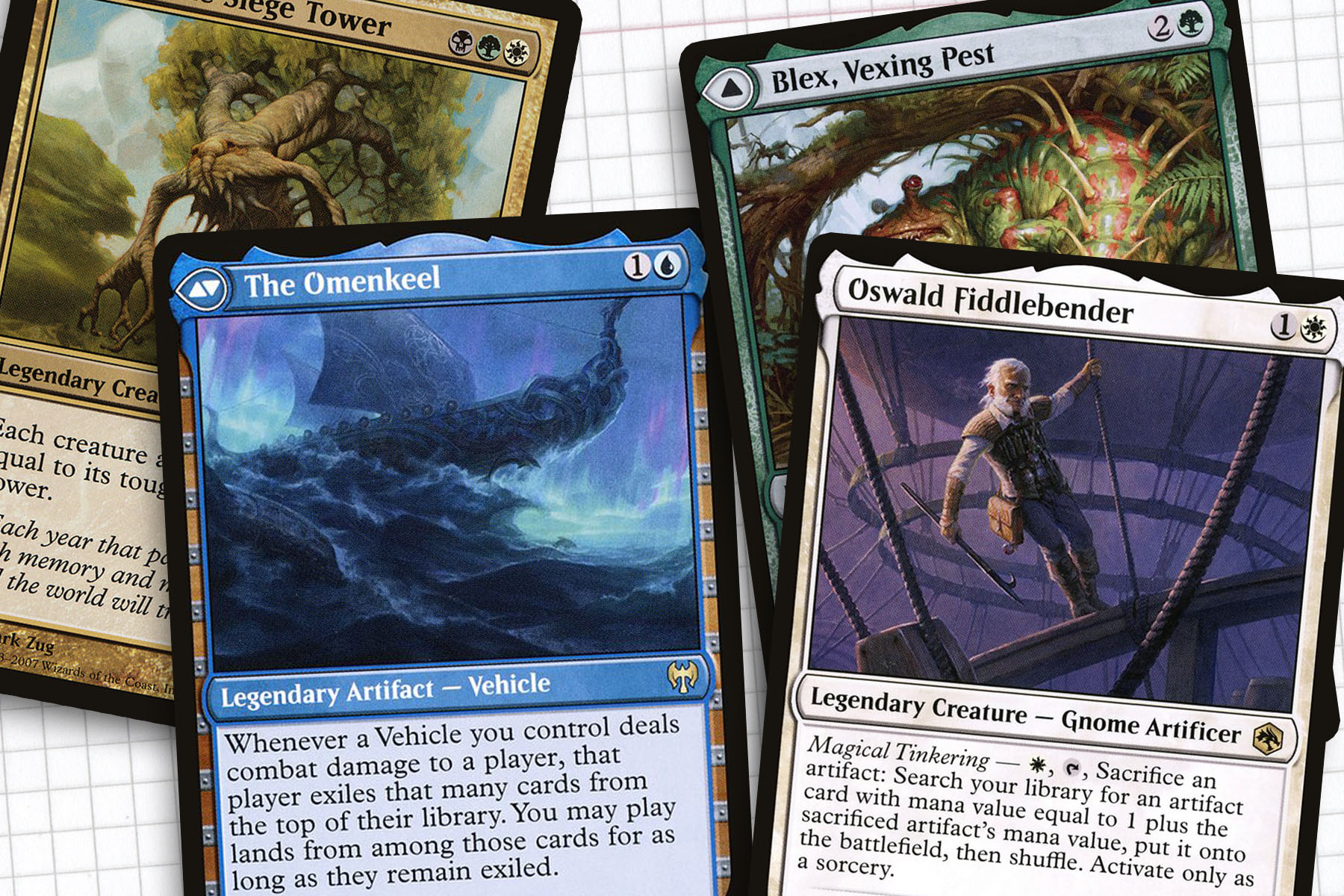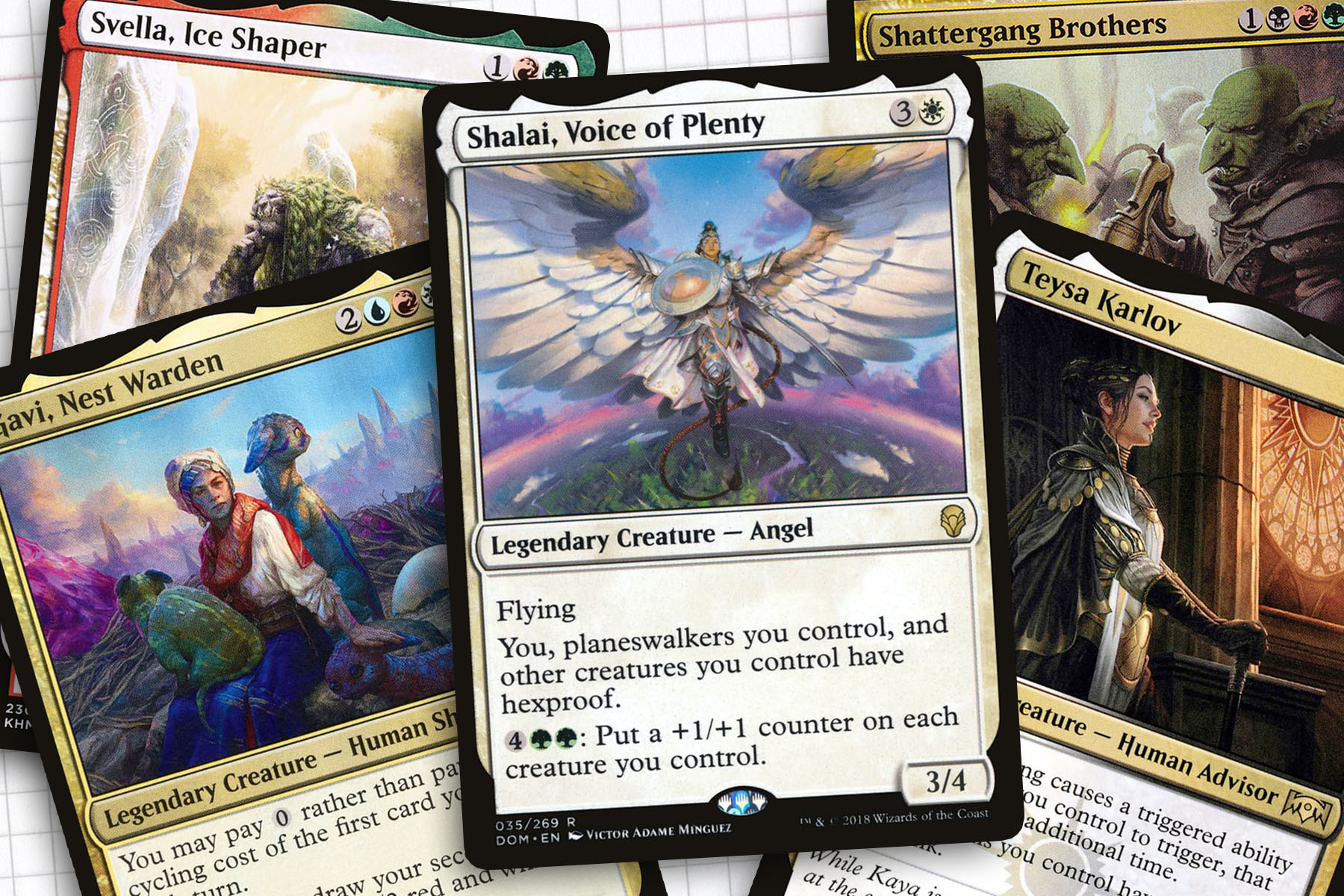It has been a very long time since I played in-person Commander. What was once a weekly tradition for much of the 2010s became something I did less and less, due to the commitments of parenthood and other parts of adult life. I think my last in-person Commander night was in early January 2020, then nothing, for over eighteen months. So I mean it when I say that I was unbelievably fortunate to be invited to a night of Commander last weekend, with two of the co-hosts of the Pokemon podcast, It’s Super Effective, and two local players, Steven and Vince.
The night was invigorating, even if it felt very brief and only two games were played. But with tons of time removed from my ideal way to play the format, the entire Year of Commander happening in the intervening time, and something like 2,300 new cards existing; the night left me with a lot of observations of how things had changed or at least, how much I had forgotten about Commander. This week, I wanted to do less of a play-by-play of the two games played, and instead reflect on eight lessons that stood about my wonderful night of Commander.

Game One
In an attempt to maintain some structure to how the night unfolded, and because none of these lessons I feel are particularly more important than any of the others, I’ve framed my observations within the context of each game. The first of which was a four player game as our fifth player had not yet arrived, involving decks helmed by Blex, Vexing Pest, The Omenkeel (a.k.a. Cosima, God of the Voyage), Oswald Fiddlebender, and Doran, the Siege Tower.
Blex was a fairly midrange, life manipulating deck; it held its own very well and was reflective of its pilot, who I’ve known in the past as a very skilled player who can feign being unthreatening until they have to be The Threat. The Omenkeel played a very committed Boat Tribal list, with a lot of vehicles and other seafaring objects. And I had chosen to start with my Doran deck, because it’s pretty solid, playing a combat-based strategy, but able to restabilize if it takes a huge blow.
And then there was my first big observation of the night:
Oswald Looks Really Fun
Oswald Fiddlebender piqued my interest during preview season, but had not stayed in my thoughts long enough to be acquired in the last few weeks. While not seeing the full range of Oswald’s abilities, I was very impressed by the interactions on display during our game. Genesis Chamber is a card that I haven’t seen on display in Commander in quite some time, but it did a lot of heavy lifting in this deck.
Not only did it mean that the Construct token created by Urza’s Saga was always gaining some power and toughness each turn, it gave Oswald an easy starting point to chain his ability, if the need presented itself. And as many people have already likely pointed out all over the internet, Esper Sentinel is a powerhouse when equipped with anything and I can now personally attest to that. I can only imagine what Scrap Trawler or Myr Retriever can do in this deck.
Armageddon is Still to be Used Sparingly
Pretty early on in this game, with no deck manipulation on my part, I found myself with Armageddon in hand and the same moral quandary I must face each time I draw it: should I cast Armageddon? I’m my younger days, I would play Desolation Angel on the regular. The experience that changed my philosophy towards casting it was a four player game where after Day of Judgment, I cast it into a pretty much empty board, meaning that it was going to be responsible for the lion’s share of the damage needed to end the game. As many of you can probably deduce, that game went on for a very long time. From that I learned that casting an Armageddon effect without having a plan of action to actually end the game within a turn or two is a huge faux pas.
This past weekend, I nearly cast the spell. I had Aetherflux Reservoir ready to go, with a battlefield including Archangel of Thune and Armadillo Cloak attached to Auriok Champion. This felt like the optimal time to strip the rest of the table of their mana resource and wrap the game up quickly—if not for making the fatal mistake of raising my profile too quickly and falling prey to River’s Rebuke twice.
Never Underestimate Boat Tribal
While I have not invested time into building a theme deck in quite some time, I always have respect for any deck builder who finds and commits to a theme off the beaten trail. The deck I played against, led by The Omenkeel, is not to be messed with. This was the deck that got me with River’s Rebuke, proving that good cards can still be on-theme, but I also had to get a laugh out of the interaction between Doran and Consulate Dreadnought.
Between Skysovereign, Consul Flagship taking out blockers and the Dreadnought hitting for much harder than intended, The Omenkeel could have milled a player out as a byproduct of their game plan with enough focus. Lastly, the deck also brought to my attention how good Dandân is with vehicles, something the pilot admitted was just a coincidence.

Game Two
Setting the stage for game two, we had: Svella, Ice Shaper, who was repping big monsters, including Eldrazi. Shalai, Voice of Plenty, who we all assumed was angel tribal, but revealed themselves to be more likely Super Friends. An unaltered Timeless Wisdom deck, led by Gavi, Nest Warden. A fairly tuned Teysa Karlov deck. And my Shattergang Brothers, who are Eldrazi in disguise.
Don’t Give Vince an Opening
There is always someone at the table who you realize you should not underestimate. I knew that was Vince from even before I sat down at the time. He’s a very thoughtful player, with a lot of answers always lurking in his hand. It started with small things, like copying Greg’s Kodama’s Reach with Reverberate to get ahead on land. One of those basic lands was Wastes—suspicious. I still completely failed to use this knowledge to my advantage.
Games can move rapidly at times, but at some point I looked up and we soon had Kozilek, the Great Distortion to contend with. The lesson truly solidified itself when Vince’s response to me exiling Kozilek with my Ulamog, the Ceaseless Hunger, was to Fling the 12/12 at me. He continued to always have an answer, as if glimpsing the future, ultimately combating the insect tokens made by The Locust God with Polukranos, World Eater to prevent himself from taking third place overall.
The Importance of Letting Cool Stuff Happen
People come to Commander for any number of reasons, but one of the biggest pulls is to do things that you can’t do in competitive formats. I’m happy to say that experience is still part of the format. Playing with more casual players, who still understand the politics and game theory, allowed fun to bubble to the surface. How else is a hydra going to fight off a legion of locusts?
But another important part of that is, as a player within the game, being mindful to allow players to not feel like their strategy is being entirely discouraged or prematurely stopped. During this game, one player was short on mana and another was playing a preconstructed deck right out of the box; there was no need to play 100% optimally. I spent an enormous amount of time just trying to calibrate when was the right moment to exile all the graveyards or to remove a problematic planeswalker. Tempting as playing more cutthroat might have been, fun can be a zero-sum game.
Know When to Pull the Trigger
Threat assessment is a critical part of playing Commander. Choices that you make on your turn reverberate as everything changes around the table, making planning very tumultuous. In my efforts to try to maintain the fun and allow people to do what their decks were built to do, I pulled a few of my punches, to the detriment of my end game. I had Spreading Plague in my hand from turn three to the end of the game and there were many times when I asked myself if this was the turn to go off.
Similarly, I had Patriarch’s Bidding in my hand for my final turn of the game and with one more turn, I could have gotten It That Betrays, Ulamog, the Ceaseless Hunger, and Reality Smasher out of the graveyard to take over the game.
Manage the Planeswalkers
Planeswalkers have had their share of analysis within my own column and even a history lesson. But internally, I had convinced myself into believing that they are not as powerful in multiplayer as they are in head-to-head. What I failed to account for was their value in the game is in direct correlation to how much attention they’re getting. In our second game the Shalai player had Serra, the Benevolent and Ajani, the Greathearted, who were left alone to accrue value. This included Serra, who was able to ultimate, creating a bit of an issue that none of us were able to overcome. I think if we had made a more concerted effort as a group of four players, we could have easily prevented that from occurring.
Generals are Safe
The biggest takeaway from my experiences last weekend was solidifying a mentality that I have wanted to see more of within the community, which seems to have been adopted, at least on a smaller scale. That being the notion that in an effort to allow decks to do their cool thing, generals should be allowed to exist on the battlefield. This is not to imply that you should just give them a social shroud, but the mentality of destroying a general immediately can be a toxic one. This is something that I feel is pivotal to minimizing the amount of discouragement around the table and maximizing the fun.
That said, I only came to this realization after the fact. I spent a good amount of my first game questioning when Doran was going to be destroyed. Because he is such a linchpin to my deck and changes the way that the game works, it should have been inevitable that a player felt that he needed to go. I’m happy to say that other than Shalai who needed to be removed to try to combat Serra’s emblem, generals were allowed to breathe and only taken out if they were a clear and present danger to a player’s overall game plan.
In the end, the games were won by the same player with Oswald and Shalai, because they planned a good defense, had good threat assessment, and knew when to use social politics to sway the table.
Overall, I had a tremendous amount of fun getting out and finally playing in-person Commander for the first time in over a year and a half. It’s certainly a feeling that was easy to take for granted no more than two years ago and now is something that I would desperately like to do again in the future. Maybe we’re almost there again. Stay safe everyone. I hope to see you next time.
Ryan Sainio is a Graphic Designer who writes about EDH and the EDH community. He has been playing Magic: the Gathering since 7th Edition in 2002 and values flavorful and fun gameplay over competitively optimized decks.

